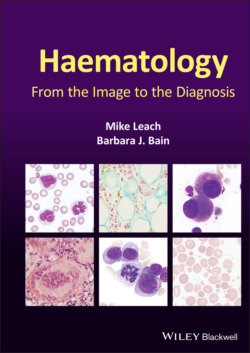Читать книгу Haematology - Barbara J. Bain, Irene Roberts - Страница 26
Оглавление17 Acute myeloid leukaemia with t(8;21)(q22;q22.1)
A 53‐year‐old woman was referred for investigation after presenting to her GP with a recent history of lethargy, myalgia, fever and headache. Her FBC showed Hb 100 g/l, WBC 3.4 × 109/l, neutrophils 0.5 × 109/l and platelets 39 × 109/l. The blood film showed small numbers of myeloblasts with some containing Auer rods. The bone marrow aspirate showed a prominent myeloblast population (approximately 40% of nucleated cells) with cytoplasmic granules (all images ×100 objective) with some showing Auer rods (top centre, top right, bottom left, bottom right). There was myeloid maturation to neutrophils with some cells showing hypogranularity (myelocytes, top left and neutrophils, bottom left, bottom right) but significantly, the nuclear morphology of maturing cells was also abnormal. Note the abnormal neutrophil segmentation (top centre, bottom right) and pseudo‐Pelger–Huët anomaly (bottom left) including complete failure of segmentation resulting in a round nucleus (bottom centre). This subtype of AML can often be predicted on the basis of the marked granulocyte dysplasia, particularly the abnormalities in nuclear morphology in the maturing myeloid cells.
The blast cells had a CD34+, CD117+, MPO+, CD13+, CD33+, CD15+, CD19+ immunophenotype. Cytoplasmic CD3 and CD79a were not expressed. Note the CD117/CD15 co‐expression; this indicates a myeloid maturation defect as CD15 is normally only acquired by maturing myeloid cells (neutrophil or monocyte lineage) when CD117 is lost. This feature can be useful in tracking minimal (or measurable) residual disease using flow cytometry as it is not seen in normal marrow cells. The karyotype was 46,XX,t(8;21)(q22;q22.1),del(9)(q13q22) indicating a RUNX1‐RUNX1T1 rearrangement and a favourable prognosis. Additional chromosomal changes, especially deletion of the long arm of chromosome 9, are common in this entity and this does not influence prognosis. The morphological features described here are typical of AML with this recurrent cytogenetic abnormality. The patient was treated with four cycles of chemotherapy and remains in remission 5 years later.
MCQ
1 Acute myeloid leukaemia with t(8;21)(q22;q22.1); RUNX1‐RUNX1T1:Can be diagnosed despite blast cells being less than 20% in blood and bone marrowMay have an increase in bone marrow eosinophils and precursorsOften shows trilineage dysplasiaShould be classified as mixed phenotype acute leukaemia when there is expression of CD19, CD79a and PAX5Shows an association with systemic mastocytosis with a KIT D816V mutationFor answers and discussion, see page 206.
